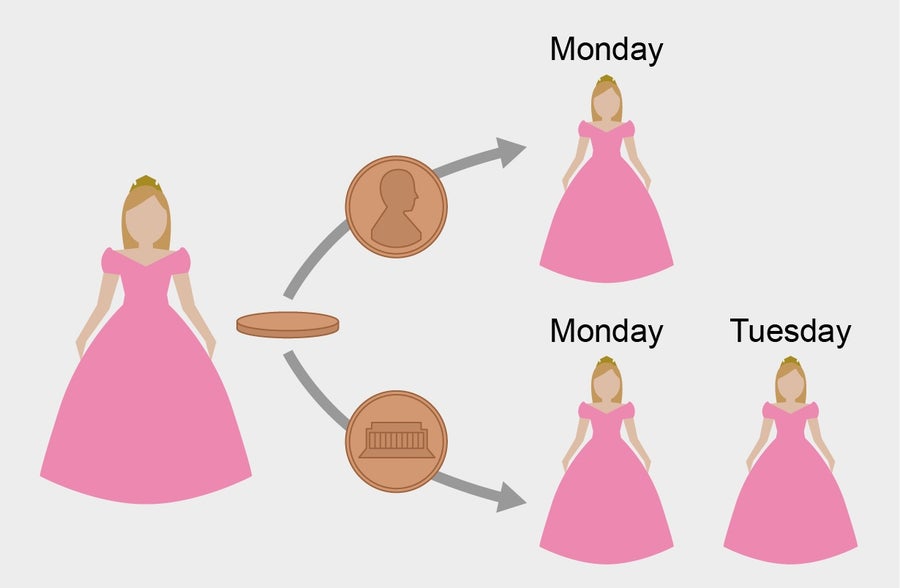Article by Manon Bischoff
The problem vexing the minds of experts is as follows: Sleeping Beauty agrees to participate in an experiment. On Sunday she is given a sleeping pill and falls asleep. One of the experimenters then tosses a coin. If “heads” comes up, the scientists awaken Sleeping Beauty on Monday. Afterward, they administer another sleeping pill. If “tails” comes up, they wake Sleeping Beauty up on Monday, put her back to sleep and wake her up again on Tuesday. Then they give her another sleeping pill. In both cases, they wake her up again on Wednesday, and the experiment ends.
The important thing here is that because of the sleeping drug, Sleeping Beauty has no memory of whether she was woken up before. So when she wakes up, she cannot distinguish whether it is Monday or Tuesday. The experimenters do not tell Sleeping Beauty either the outcome of the coin toss nor the day.
They ask her one question after each time she awakens, however: What is the probability that the coin shows heads?

Depending on the outcome of a coin toss, scientists will wake up Sleeping Beauty either once (heads) or twice (tails). (Illustration Credit: Spektrum der Wissenschaft/Manon Bischoff, styled by Scientific American)
Put yourself in the position of Sleeping Beauty: You wake up, you don’t know what day it is, and you don’t know if you have been woken up before. You only know the theoretical course of the experiment.
My first intuition was that Sleeping Beauty should guess 1/2.The probability of the coin landing on heads or tails—regardless of the rest of the experiment—is always 50 percent. U.S. philosopher David Lewis held the same view when he learned of the problem. After all, one could even flip the coin before sending Sleeping Beauty to sleep. By the experiment’s design, she does not have any extra clues to the situation, so logically she should state the probability as 1/2.
But there are also conclusive arguments in favor of a probability of 1/3. If you think through Sleeping Beauty’s experience, then three scenarios can occur:
She wakes up Monday, and heads was thrown.
She wakes up Monday, and tails was thrown.
She wakes up Tuesday, and tails was thrown.
What are the probabilities for each event? You can investigate this both mathematically and empirically. Suppose you flip a coin 100 times and get tails 52 times and heads 48 times. Put another way, the Monday/heads scenario occurs 48 times, and Monday/tails and Tuesday/tails occur 52 times each.
Because Tuesday/tails always follows Monday/tails, the probabilities for all three events are equal—and must therefore be 1/3. When Sleeping Beauty is awakened and asked to answer what the probability of the coin toss was for heads, she should therefore answer 1/3, , according to this reasoning.

If after 100 flips, you got heads 48 times and tails 52 times, you could apply those numbers to Sleeping Beauty’s Monday and Tuesday scenarios. You’d discover that these three situations are more or less equally likely to occur.( Illustration Credit: Spektrum der Wissenschaft/Manon Bischoff, styled by Scientific American.)
Philosopher of science Adam Elga of Princeton University, who popularized the Sleeping Beauty problem in 2000, came to this conclusion. He formulated his argument in a mathematically sound way. If Sleeping Beauty is told when she wakes up that today is Monday (M), then the probability of Monday/heads (M, H) and Monday/tails (M, Z) is indisputably equal: P(M, H) = P(M, Z) = 1/2, where P stands for probability. On the other hand, if Sleeping Beauty wakes up and learns that tails have been thrown, then that day could equally be either Monday or Tuesday (T), meaning P(M, Z) = P(T, Z) = 1/2.
According to the calculus of conditional probabilities, it follows that in the general case (without Sleeping Beauty receiving any additional information), the three values are equal: P(M, Z) = P(M, H) = P(T, Z). Because all three probabilities must add up to 1, each individual value is 1/3. In other words, because Sleeping Beauty is awakened twice as often in the case of tails as in the case of heads, she should answer with 1/3, from Elga’s point of view.
The problem vexing the minds of experts is as follows: Sleeping Beauty agrees to participate in an experiment. On Sunday she is given a sleeping pill and falls asleep. One of the experimenters then tosses a coin. If “heads” comes up, the scientists awaken Sleeping Beauty on Monday. Afterward, they administer another sleeping pill. If “tails” comes up, they wake Sleeping Beauty up on Monday, put her back to sleep and wake her up again on Tuesday. Then they give her another sleeping pill. In both cases, they wake her up again on Wednesday, and the experiment ends.
The important thing here is that because of the sleeping drug, Sleeping Beauty has no memory of whether she was woken up before. So when she wakes up, she cannot distinguish whether it is Monday or Tuesday. The experimenters do not tell Sleeping Beauty either the outcome of the coin toss nor the day.
They ask her one question after each time she awakens, however: What is the probability that the coin shows heads?

Depending on the outcome of a coin toss, scientists will wake up Sleeping Beauty either once (heads) or twice (tails). (Illustration Credit: Spektrum der Wissenschaft/Manon Bischoff, styled by Scientific American)
Put yourself in the position of Sleeping Beauty: You wake up, you don’t know what day it is, and you don’t know if you have been woken up before. You only know the theoretical course of the experiment.
My first intuition was that Sleeping Beauty should guess 1/2.The probability of the coin landing on heads or tails—regardless of the rest of the experiment—is always 50 percent. U.S. philosopher David Lewis held the same view when he learned of the problem. After all, one could even flip the coin before sending Sleeping Beauty to sleep. By the experiment’s design, she does not have any extra clues to the situation, so logically she should state the probability as 1/2.
But there are also conclusive arguments in favor of a probability of 1/3. If you think through Sleeping Beauty’s experience, then three scenarios can occur:
She wakes up Monday, and heads was thrown.
She wakes up Monday, and tails was thrown.
She wakes up Tuesday, and tails was thrown.
What are the probabilities for each event? You can investigate this both mathematically and empirically. Suppose you flip a coin 100 times and get tails 52 times and heads 48 times. Put another way, the Monday/heads scenario occurs 48 times, and Monday/tails and Tuesday/tails occur 52 times each.
Because Tuesday/tails always follows Monday/tails, the probabilities for all three events are equal—and must therefore be 1/3. When Sleeping Beauty is awakened and asked to answer what the probability of the coin toss was for heads, she should therefore answer 1/3, , according to this reasoning.

If after 100 flips, you got heads 48 times and tails 52 times, you could apply those numbers to Sleeping Beauty’s Monday and Tuesday scenarios. You’d discover that these three situations are more or less equally likely to occur.( Illustration Credit: Spektrum der Wissenschaft/Manon Bischoff, styled by Scientific American.)
Philosopher of science Adam Elga of Princeton University, who popularized the Sleeping Beauty problem in 2000, came to this conclusion. He formulated his argument in a mathematically sound way. If Sleeping Beauty is told when she wakes up that today is Monday (M), then the probability of Monday/heads (M, H) and Monday/tails (M, Z) is indisputably equal: P(M, H) = P(M, Z) = 1/2, where P stands for probability. On the other hand, if Sleeping Beauty wakes up and learns that tails have been thrown, then that day could equally be either Monday or Tuesday (T), meaning P(M, Z) = P(T, Z) = 1/2.
According to the calculus of conditional probabilities, it follows that in the general case (without Sleeping Beauty receiving any additional information), the three values are equal: P(M, Z) = P(M, H) = P(T, Z). Because all three probabilities must add up to 1, each individual value is 1/3. In other words, because Sleeping Beauty is awakened twice as often in the case of tails as in the case of heads, she should answer with 1/3, from Elga’s point of view.
Last edited:
